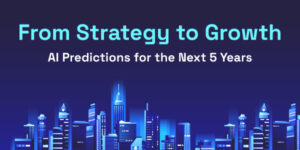What is DataOps?
DataOps is a process that streamlines data management by combining lean manufacturing, Agile, and DevOps principles. It involves building, testing, deployment, and management of data products and applications by introducing automation and agility. It’s essentially DevOps for data, emphasizing efficiency and teamwork to extract insights from data more quickly.
DataOps empowers organizations to:
- Deliver high-quality data at an accelerated pace.
- Reduce errors and inconsistencies in data pipelines.
- Enhance collaboration between data and operations teams.
- Promote a culture of data governance and compliance.
Evolution of DataOps
DataOps is a fascinating concept born from the success of DevOps in the software development world. DevOps revolutionized software development by breaking down silos between development and operations teams. It championed effective teamwork and an agile atmosphere, which leads to faster deployment and higher software quality. This collaborative atmosphere proved transformative, paving the door for a similar approach in the ever-expanding field of data, known as DataOps.
The other great influence on DataOps’s methodology is the adoption of Agile methods. Agile practices are built on iterative development and feature continuous improvement, which resonates with DataOps. The same data pipelines, which once were static, are now constantly monitored, tested, and fine-tuned under a cycle of changing requirements and user feedback.
Core Principles of DataOps
DataOps hinges on a set of core principles that guide its implementation:
- Collaboration and Communication: It is essential to break down silos between the operations and data teams to ensure continued communication. This ensures business goals for each team member is aligned properly.
- Automation: The process of automating repetitive tasks along the data lifecycle in order to minimize human errors and save valuable resources for more strategic work.
- Continuous Integration and Delivery (CI/CD): DataOps, just like software development, embraces CI/CD practices. Automated testing for functionality and data quality is performed on the central repository, where data pipelines are continuously integrated. It ensures regular and dependable deployments of data pipelines.
- Monitoring and Testing: Data pipelines are constantly monitored for performance and errors. Every stage rigorously tests data accuracy to maintain its integrity and avoid any issues that might arise downstream.
Key Practices in the DataOps Toolbox
DataOps leverages a variety of tools and practices to automate and streamline data workflows:
- Data Orchestration: Tools like Apache NiFi or Luigi can provide a means by which information is coordinated between disparate systems or applications. This ensures that information flows through properly ordered processes and is delivered to the appropriate destinations.
- Version Control: Data engineers use version control systems such as Git to store analytics code and track changes made to it. This mechanism makes it possible to revert to previous versions if needed and facilitates collaboration between data engineers.
- Configuration Management: DataOPs tools manage the configuration of data pipelines along with environments. This ensures uniformity across deployments and hence easing troubleshooting when issues arise.
DataOps Tools
DataOps relies on a diverse set of tools to manage the various aspects of data pipelines:
- Data Integration and ETL Tools: Tools such as Informatica, Talend, Apache NIFI, and DataStage help to integrate data from heterogeneous sources into a single source. More importantly, such tools are key to facilitate data extraction, transformation, and loading (ETL) to prepare data for analysis.
- Orchestration and Workflow Management: Platforms such as Luigi and Apache Airflow, help organize the data pipeline’s execution. These technologies build workflows, plan tasks, and run dependencies automatically in the data lifecycle.
- Monitoring and Logging: DataOps pipelines need continuous monitoring for performance and error checks.Prometheus (open-source) collects data and triggers alerts, Grafana visualizes it for easy troubleshooting, and ELK Stack (another open-source trio) analyzes logs to find and fix problems.
Implementing DataOps: From Strategy to Execution
Taking the plunge into DataOps requires careful planning and execution:
- Defining Your DataOps Strategy: Start by clearly understanding your organization’s needs and challenges. After that, identify the data pipelines which can gain mostly from a DataOps approach.
- Building a Cross-functional DataOps Team: Build a Cross-functional team with a mix of talents, from data engineers and analysts to operations professionals, data scientists, and business stakeholders.
- Cultivating a DataOps Culture: Cultivate an organizational culture that supports collaboration and constant improvement. Encourage transparent channels of communication that will facilitate free ideas flow and knowledge sharing among team members.
Challenges and Solutions
Like any transformative initiative, DataOps implementation comes with its own set of challenges:
- Data Quality Issues: It is really essential to maintain high data quality throughout the data life cycle. DataOps practices, such as data profiling, cleansing, and validation, tend to ensure data accuracy and consistency.
- Integration of Diverse Tools and Systems: Organizations usually have complex data ecosystems because of multiple tools and technologies. DataOps tools with open APIs and support for heterogeneous environments can assist in integrating various systems smoothly.
- Scaling Data Operations: The DataOps practice has to be scalable because of the volume and complexity of data in recent times. Hence, It is really vital to pay great attention to cloud solutions and their agility, elasticity, and containerization technologies.
Conclusion
DataOps is not just a set of tools, but a cultural shift that enables organizations to get the most out of their data assets. It build the path for effective data management, superior analytics, and eventually data-driven business success. It optimizes data pipelines, encourages cooperation, and embraces continuous enhancement.
Share this glossary

